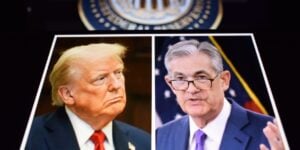Very little, really. Despite what we teach our students in Principles classes, and in some more advanced classes on Macroeconomics and Money & Banking, the relationship between changes in the stance of monetary policy and changes in interest rates are ambiguous.
The standard story, having its roots in the interest rate theories of old Keynesianism, and reinforced in modern New Keynesian models—where often money is proxied by a rule for the central bank in setting the policy interest rate—is that expansionary monetary policy lowers interest rates and contractionary policy raises rates. This ‘liquidity effect’ story, when coupled with the ceteris paribus clause, is unobjectionable.
It is also woefully incomplete.
First, and most importantly, we must remember that market actors are forward-looking. If money becomes tighter than market actors expect, rates may fall, and if money becomes looser than market actors expect, rates may rise. In other words, interest rates are largely pro-cyclical: they rise in booms and fall during busts. The reasons for this are many, but we can identify two chief causes. Take the example of a boom brought about by loose money. First is the expansion in available investment opportunities during booms, which increases the demand for loanable funds by investors, putting upward pressure on rates. Second is the rise in expected future income relative to present income, which increases demand for loanable funds by consumers, as they transfer purchasing power from their future selves to their present selves, also putting upward pressure on rates. The reverse happens in the event of a bust brought about by tight money.
Of course, we also have to pay attention to the effects of changing inflation expectations on interest rates. Since, except in the event of supply shocks, inflation tends to be the result of more rapidly-than-expected increases in aggregate demand, and hence looser-than-expected monetary policy, the positive effect of loose money on interest rates is reinforced.
Milton Friedman famously remarked, somewhat exasperatedly, that the fallacy identifying low rates with expansionary policy was alive and well. Monetary economics blogger Scott Sumner, perhaps the most well-known proponent of NGDP level targeting, deserves much credit for trying to bury this fallacy once and for all. Thinking about interest rates as the sole, or even chief, channel for monetary policy is empirically narrow, and theoretically shaky. Instead of focusing on the effects of monetary policy on a single relative price (interest, remember, is the price of time), studies of monetary policy should focus on the stance of monetary tightness or looseness more broadly, and relative to market actor expectations. Nominal income, either levels or growth, is a much better proxy for the stance of monetary policy than interest rates, although it too is imperfect.





